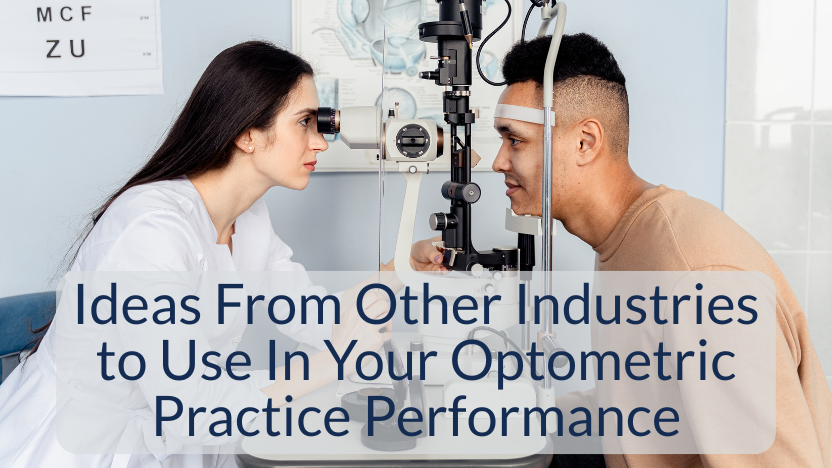Ideas From Other Industries to Help Boost Per-Exam Revenue
Posted by EyePromise on May 7th 2025
There are many places throughout the eyecare industry where you can gather inspiration and ideas for your optometry practice. However, there’s nothing wrong with looking to other industries for even more ideas that may work even better. Griffin Christenson, OD, shared what he found applicable to his practice via Review of Optometric Business and the successes those ideas brought.
Special Testing Led by Techs
Dr. Christenson learned about having technicians administering special testing from diagnostic labs in general medicine. This helps doctors have more time with patients and streamline eye health issue monitoring for the practice and patients. OCT, visual fields, MPOD measurement, intraocular pressure (IOP) testing, and more can all be operated by skilled techs who are designated and trained in that device.
Christenson recommends establishing dedicated appointments with these techs specifically for testing. Then, a physician reviews the results and calls the patient to discuss or has the staff schedule a follow-up. These dedicated appointments provide more scheduling flexibility for patients who need routine monitoring, and they no longer have to wait for a doctor to be available.

Dr. Christenson shared a few necessities to consider for other eye care professionals (ECPs) looking to implement this idea:
- Precise testing protocols, including instructions for what to do with abnormal findings
- Accurate documentation and coding
- A reliable review and communications system for doctors and patients to share results
A Consultative Approach
Inspired by companies like Apple and Nordstrom, Dr. Christenson shifted his optical to a more consultative method. His optical staff presents objective measurements and options that fit the patient’s needs, but the experience is heavily patient led with staff providing “expert” guidance. He explained,
“I believe in taking a deeper approach and tying a product or feature more directly to how it will help the person in front of you and educating them on that front.”
Additionally, Christenson supports his optical sales through price match guarantees and comprehensive warranties. These strengthen his staff’s conversations and ultimately help boost sales. He offers these additional pointers for ECPs looking to implement this tactic:
- Provide staff training in education vs. sales language and objection handling.
- Support educational messaging with visual aids to demonstrate differences between options.

Implement a Wellness Screening Program
Taken from proactive health screening models in concierge medicine, Dr. Christenson developed an ocular wellness program to personalize risk assessment and ongoing monitoring. The program is dedicated to bridging the gap between routine and medical eye exams and allows for earlier detection of macular health issues and, therefore, better patient outcomes.
Supported by staff training and educational materials to explain the importance of early identification, the program has been positively received by patients. Dr. Christenson shared recommendations for ECPs who want to activate a similar program:
- Position the program as an educational opportunity vs. an additional service/fee.
- Provide educational material to demonstrate the differences between measurement methods and proactive vs. reactive care.
- Establish accurate coding to differentiate wellness and medical screenings.
The EyePromise® Zx Pro™ Macular Pigment Optical Density (MPOD) Measurement Device
While Dr. Christenson facilitates his early detection program with an OCT, EyePromise offers a more affordable and still accurate, reliable, and repeatable method of measuring macular health. The Zx Pro MPOD measurement device uses tried-and-true heterochromatic flicker photometry (HFP) technology to directly measure the levels of macular pigments in the eye.
The Zx Pro then provides a numerical score, known as the MPOD score, correlating to the patient’s macular health. The MPOD score falls between 0.0 density units (d.u.) (lowest) and 1.0 d.u. (highest), with “optimal” being considered 0.5 d.u. However, the U.S. national average sits at 0.34 d.u., putting even more emphasis on early detection and intervention.
The Zx Pro delivers a portable, self-administered exam that requires less than 3 minutes and can be taken in the exam room, waiting room, testing lane, or wherever the patient is waiting. It does not require doctor or staff administration, freeing up both to tend to other tasks. Additionally, it doesn’t require dedicated space, and EyePromise provides staff training and patient education material at no cost, making it an easy implementation from start to finish.

Building a successful optometry practice starts with great eye care but can be accelerated by utilizing tactics and programs that work for other industries. Finding the right practice partner can make the whole process seamless. Learn more about partnering with EyePromise and PRN Vision Group to bring your wellness program to life.

